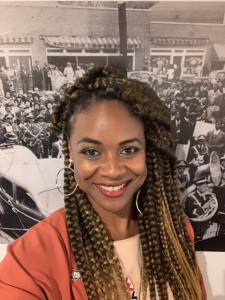Temple University Libraries is pleased to welcome Synatra Smith, PhD as our new Council on Library and Information Resources (CLIR) Postdoctoral Fellow. In this joint position, she is splitting her time between the Libraries and the Philadelphia Museum of Art (PMA). While working with the Libraries, Synatra will focus on digital scholarship projects related to African American art history in collaboration with the Loretta C. Duckworth Scholars Studio. She also plans to work with the Charles L. Blockson Afro-American Collection.
Synatra earned her PhD in Global and Sociocultural Studies with a concentration in Anthropology from the School of International and Public Affairs at Florida International University.
In October 2020, Beckie Dashiell, editor for Temple University Libraries, had the opportunity to check in with Synatra and learn more about her research interests and the work she is engaging in at the Libraries and the PMA.
Beckie Dashiell: First of all, welcome to Temple Libraries! Can you share with our readers more information about your research interests and ongoing projects?
Synatra Smith: My research focuses on the creation, perpetuation, and transformation of the socio-political intersectional Black cultural landscape with special attention to the ways in which virtual and physical space are used as environments to conceptually and practically transform Black identification processes, as well as the material culture that contributes to this phenomenon.
I’ve been working in the galleries, libraries, archives, and museums (GLAM) field for the past five years officially in museum education, but I’ve also curated, worked in collections, managed an outreach initiative, etc. Typical small museum work where each department is a staff of one and everyone does everything. I’ve painted walls, been the bartender at events, testified in front of the County Council for funding, and written grants. Outside of this fellowship, I’m working on a multi-chapter report to historically contextualize the use of racially restrictive deed covenants in Hyattsville, Maryland as a federally-sanctioned method of residential segregation during the first half of the twentieth century.
Beckie: Can you tell us a little bit about the kind of work you’ll be doing here at the Libraries, particularly in the Scholars Studio? What goals do you have for your time here?
Synatra: The Scholars Studio offers me an amazing opportunity to learn about a variety of digital tools for data collection and analysis that I intend to apply to my collection and interpretation of Black art, history, and culture. I’m currently participating in a few Zoom workshops to learn photogrammetry, text analysis with Python, and 3D scanning and modeling. I’m kind of creating my Batman utility belt of digital humanities tools that will allow me to develop an interactive exhibition that showcases current local Black art and scholarship through an Afrofuturist lens that reimagines time and space in order to speculate about the future.
Beckie: As part of your fellowship, you’ll be working jointly with the Libraries and the PMA. What kinds of opportunities do you see this collaboration offering?
Synatra: PMA’s Library and Archives is working on a Wikidata project to link their collection to those records, and that data can be queried using SPARQL [a coding language] to visualize it in some fascinating ways. We’re also creating blog posts about local Black artists in PMA’s collection and we’ll be conducting oral histories with these artists soon, all of which can be added to Wikidata and linked back to PMA’s website. I’d like to do something similar with Temple Libraries’ collection so that when a person Googles one of these folks, they’ll come across their items in both of these organizations’ collections and archives.
Also, both of these institutions are providing a launchpad for my own research project to explore the myriad ways in which Black artists and scholars in Philadelphia reimagine and conceptualize their communities. I am going to be working on capturing a broad spectrum of materials, from murals, zines/comics, posters, fashion/cosplay/textiles, and performance art, to three-dimensional models of sculptures and monuments, and using linked data queries and mapping tools for data visualization.
Beckie: Can you envision any potential impacts for the kind of work you are doing?
Synatra: As a true millennial, I not only have a full time fellowship and a research project, I also work with a childhood friend and his fraternity brother on a mobile Black culture trivia app called Trivia Black. I recently started brainstorming ways to integrate a gaming experience into this project potentially through virtual reality and/or augmented reality to create a more interactive digital exhibition model. Think Pokemon Go or the Sims but Black, local, and scaled way down to fit within a 2 year fellowship.
Also, something Trivia Black talks through pretty often is how to make Black history not feel so heavy, which can be particularly difficult thanks to the legacies of enslavement, disenfranchisement, and terrorism against Black people both historically and currently. We try to be very intentional about the way we phrase questions, which is something I also do in my work more generally. The story may start with an injustice but I try to shine a light on the way we’ve fought against that oppression. Relatedly, I recently hosted a panel discussion where one of the panelists explained that her organization’s work integrates spiritual healing practices when the community interacts with the archive to soothe the very deep emotions that often arise. With all of that being said, I’m thinking of ways to keep the narratives pretty balanced between celebratory and tragic, and how to be responsible when tackling Black trauma in an interactive, gamified virtual exhibition.
Beckie: Thanks so much, Synatra! We look forward to checking back in with you over the course of your fellowship, and seeing how your project continues to develop
Editor’s note: A condensed version of this interview appears in the Fall 2020/Winter 2021 issue of Speaking Volumes, the newsletter for friends of Temple University Libraries.

